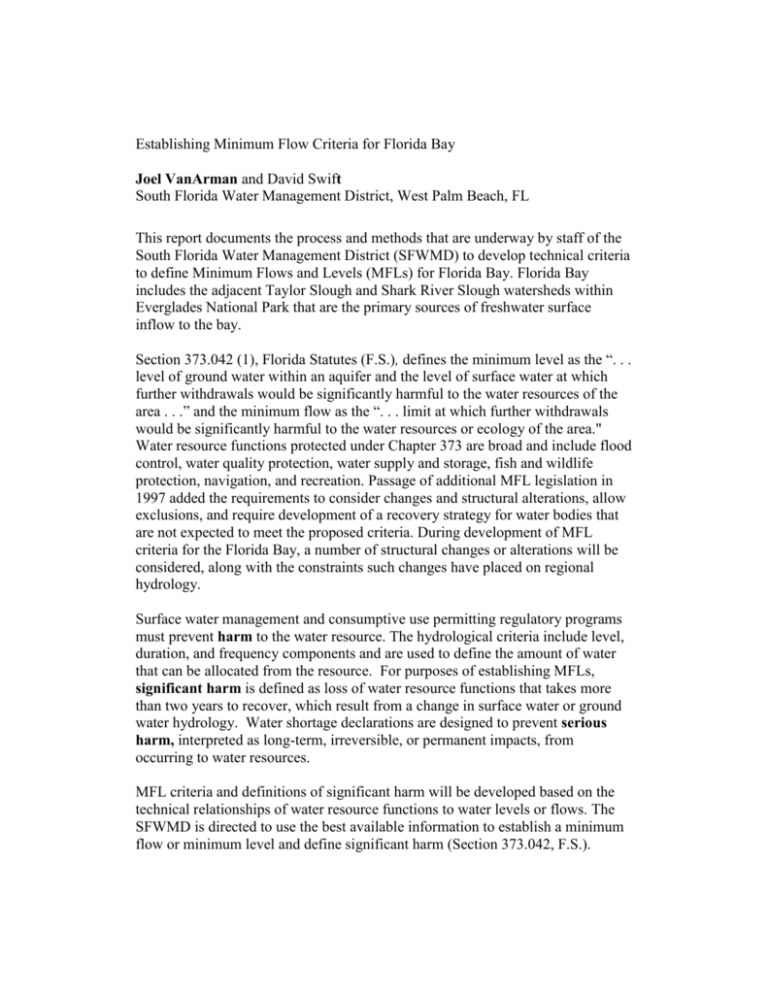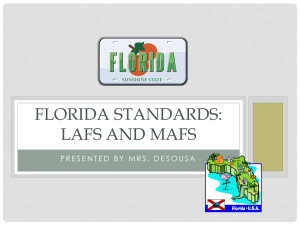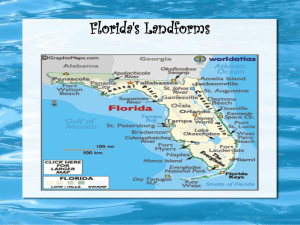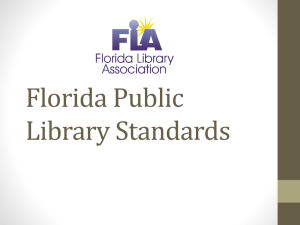Establishing Minimum Flow Criteria for Florida Bay
advertisement

Establishing Minimum Flow Criteria for Florida Bay Joel VanArman and David Swift South Florida Water Management District, West Palm Beach, FL This report documents the process and methods that are underway by staff of the South Florida Water Management District (SFWMD) to develop technical criteria to define Minimum Flows and Levels (MFLs) for Florida Bay. Florida Bay includes the adjacent Taylor Slough and Shark River Slough watersheds within Everglades National Park that are the primary sources of freshwater surface inflow to the bay. Section 373.042 (1), Florida Statutes (F.S.), defines the minimum level as the “. . . level of ground water within an aquifer and the level of surface water at which further withdrawals would be significantly harmful to the water resources of the area . . .” and the minimum flow as the “. . . limit at which further withdrawals would be significantly harmful to the water resources or ecology of the area." Water resource functions protected under Chapter 373 are broad and include flood control, water quality protection, water supply and storage, fish and wildlife protection, navigation, and recreation. Passage of additional MFL legislation in 1997 added the requirements to consider changes and structural alterations, allow exclusions, and require development of a recovery strategy for water bodies that are not expected to meet the proposed criteria. During development of MFL criteria for the Florida Bay, a number of structural changes or alterations will be considered, along with the constraints such changes have placed on regional hydrology. Surface water management and consumptive use permitting regulatory programs must prevent harm to the water resource. The hydrological criteria include level, duration, and frequency components and are used to define the amount of water that can be allocated from the resource. For purposes of establishing MFLs, significant harm is defined as loss of water resource functions that takes more than two years to recover, which result from a change in surface water or ground water hydrology. Water shortage declarations are designed to prevent serious harm, interpreted as long-term, irreversible, or permanent impacts, from occurring to water resources. MFL criteria and definitions of significant harm will be developed based on the technical relationships of water resource functions to water levels or flows. The SFWMD is directed to use the best available information to establish a minimum flow or minimum level and define significant harm (Section 373.042, F.S.). Florida Bay is an internationally recognized ecosystem due to its proximity to the Everglades, the largest subtropical wetland in the United States. MFL criteria and definition of significant harm for Florida Bay will be based on defining the amount of water needed to protect water resource functions of the system against significant harm. These water resource functions may include the following: a. maintain desired salinity conditions within nearshore areas of Florida Bay b. support freshwater, estuarine and marine ecosystems, c. provide natural biological filtering and nutrient cycling, d. provide dry season refugia for aquatic wildlife, and e. prevent undesirable changes in seagrass vegetation and periodic algal blooms. Water deliveries to Florida Bay depend directly on the flow of water through Everglades National Park from upstream areas, especially the Water Conservation Areas (WCA) and the South Dade Conveyance System. Everglades water levels are managed based on regulation schedules in the WCAs and a rainfall based water delivery plan for Everglades National Park (ENP). A first step in the determination of MFLs for Florida Bay is to evaluate the effects of the MFL water level criteria that have already been established for ENP and the proposed restoration projects and water delivery criteria for Everglades National Park to determine what effects these deliveries will have on Florida Bay. Minimum flow criteria for Florida Bay will be based on establishing quantitative relationships between the amount of water flow provided to the bay (or by inference, water levels in adjacent upland systems) and measured or measurable effects on water resources, including salinity, water quality, vegetation, fish and wildlife. The first steps in this analysis involve a review of available literature, historical water level, flow and salinity and ecological data, and data from mathematical water management, natural systems and hydrodynamic computer models that include Florida Bay. Impacts associated with significant harm in other estuaries in south Florida will also be examined to determine whether they can be applied to Florida Bay. Such effects include widespread and frequent loss of lowsalinity habitat, frequency and extent of nuisance algal blooms, and widespread impacts to seagrasses, coastal vegetation communities or wildlife populations and that require more than two years for recovery to occur. Technical relationships for the Florida Bay will include analyses of the effects of water levels and flows on salinity, effects of salinity on plant and wildlife communities, and the occurrence of destructive events such as the dieoff of seagrasses, algal blooms and widespread changes in the distribution of critical habitats or salinity regimes, to the extent that these impacts can be linked to low freshwater inflow conditions Florida Bay “no harm” standards will eventually be derived from model simulations for the year 2020 that include implementation of the features that are identified in the Florida Bay Feasibility Study as part of the Comprehensive Everglades Restoration Plan (CERP) to achieve restoration of the Bay. As restoration progresses, it is anticipated that the resource will improve and MFL criteria will need to be revised periodically to reflect the changing condition of the resource. The SFWMD needs the assistance of the research community in two areas. The first is to determine which of the critical resources are most sensitive to the effects of freshwater inflow (i.e what is the MFL designed to protect?). By identifying and protecting the most sensitive resources, the assumption is made that other, less sensitive resources are also protected. The second need is to identify or develop quantitative relationships between freshwater inflow and resource impacts. This requires determination of a degree of resource impact that constitutes “significant harm” and determination of the minimum amount of water (defined in terms of flow rate or water level, duration or hydroperiod, and return frequency of exceedances) needed to prevent this condition from occurring. Examples are provided to show how MFL criteria have been developed and applied by the SFWMD in other South Florida coastal systems. Joel, VanArman, South Florida Water Management District, P.O. Box 24680, West Palm Beach, FL , 33406, Phone: 561-682-6715, Fax: 561-682-6442, vanarman@sfwmd.gov, Question 1









